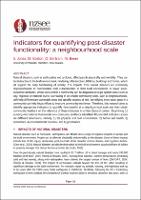| dc.description.abstract | Natural disasters, such as earthquakes and cyclones, affect people physically and mentally. They can be destructive to the built environment, hindering infrastructure, lifelines, buildings and homes, which all support the daily functioning of society. The impacts from natural disasters are commonly disproportionate to communities with vulnerabilities in their built environment or lower socio-economic attributes. Weak spots within a community can be disguised at larger spatial scales such as city, regional, or national levels. Narrowing in on smaller community units, such as neighbourhoods, will help differentiate vulnerable areas and specific sources of risk. Identifying these weak spots in a community can help focus efforts to improve community resilience. Therefore, this research aims to identify appropriate indicators to quantify functionality at a neighbourhood scale and then obtain community feedback on the relevance of these indicators in a New Zealand context. Examining 11 existing international frameworks on community resilience identified 48 potential indicators across six different dimensions, namely: 1) the physical and built environment, 2) human and health, 3) economics, 4) environmental, 5) social, and 6) governance. | |

